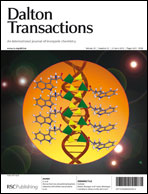[Zn(HPO3)(C11N2O2H12)] and [Zn3(H2O)(PO4)(HPO4)(C6H9N3O2)2 (C6H8N3O2)]: homochiral zinc phosphite/phosphate networks with biofunctional amino acids†
Abstract
Two new homochiral inorganic–organic hybrid frameworks [Zn(HPO3)(C11N2O2H12)] (denoted as ZnHPO-CJ56) and [Zn3(H2O)(PO4)(HPO4)(C6H9N3O2)2(C6H8N3O2)] (denoted as ZnPO-CJ57) have been hydrothermally synthesized in the presence of chiral
![Graphical abstract: [Zn(HPO3)(C11N2O2H12)] and [Zn3(H2O)(PO4)(HPO4)(C6H9N3O2)2 (C6H8N3O2)]: homochiral zinc phosphite/phosphate networks with biofunctional amino acids](/en/Image/Get?imageInfo.ImageType=GA&imageInfo.ImageIdentifier.ManuscriptID=C001621G&imageInfo.ImageIdentifier.Year=2010)

 Please wait while we load your content...
Please wait while we load your content...